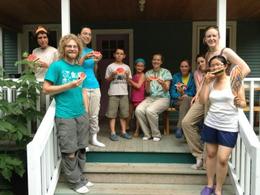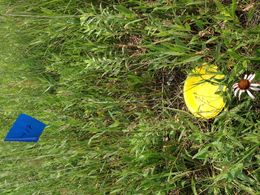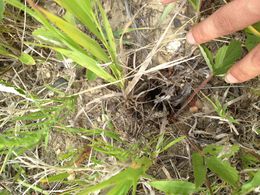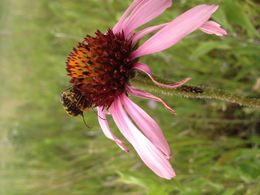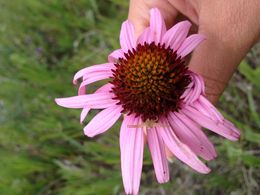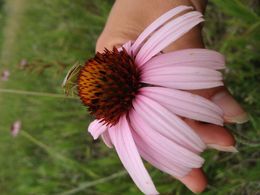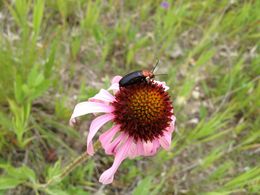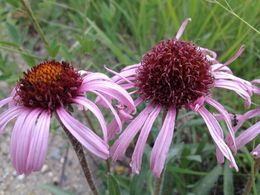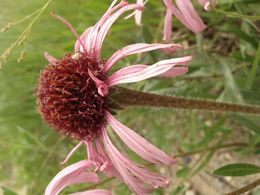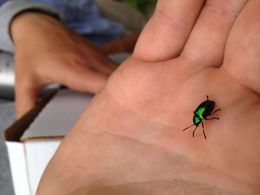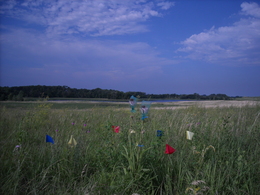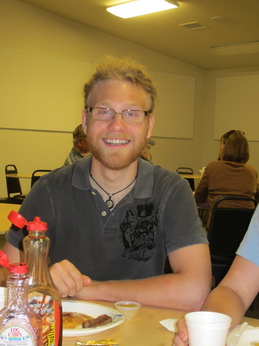|
|
Monday was incredibly hot in Kensington, but the heat could not keep Team Echinacea from their work! Everyone is very busy working on their individual projects. Some members are beginning to get results in the form of shriveled styles, aphid counts, video footage of pollinators, and the end dates for Echinacea that have already finished flowering! The first flower to finish up in my phenology experiment was done flowering on Sunday, July 1st! Isn’t that crazy? It seems like it’ll be an early season for Echinacea this year.
Other than individual projects, a few members of the Team went out and continued with phenology in C1 Monday morning. We also had a crew go out in the afternoon. They finished measuring in the inbred 1 garden.
At the end of the day, everyone cooled off on the porch of Hjelm house with some refreshing watermelon slices.

We, well, most of us, headed out to the Hjelm House to assess phenology in the Common Garden. Those that were not there were out in the remnants/preserves working on individual projects. Shona went out at Hegg Lake to perform some angustifolia and pallida crosses. Maria also went out to Hegg where she looked at dicanthelium. Once Common Garden phenology was finished, Andrew worked on his pollinator efficiency experiment. Kelly and Lydia headed out to a few remnants to do phenology and assess within-remnant crosses, respectively. Lydia had a few crosses that were entirely successful as well as some ambiguous results.

The afternoon was fairly relaxing and comprised of a trip into Alexandria, laundry, frisbee, and playing with Felix, the new kitten.
Despite the heat and humidity, Friday was yet another productive field day for Team Echinacea.
This morning everyone worked on their individual projects. Since my pitfall traps are ready to go, Greg and I placed pollinator traps on different prairie remnants. Pollinator traps are these nifty –and apparently hard to come by– yellow bowls that you fill with soapy water. Traveling from remnant to remnant, we also discovered that there’s a giant hole where the landfill prairie remnant used to be…

Later this morning, equipped with buckets as chairs, Greg and I headed up to one of the hills around Hegg Lake to observe some large soil-nesting bees. After an hour of watching, we saw two bees land in different holes, but no bees emerge. We’re not sure whether these bees are solitary or eusocial.
I also scored some pictures of the arthropod life on Echinacea heads.


  
Here is the “fuzzy” Echinacea head from the Kittleson roadside. Echinacea styles typically shrivel when successfully pollinated and persist when unpollinated or pollinated with incompatible pollen. In the case of this poor plant, the “fuzziness” is caused by all of the styles persisting, indicating that this plant hasn’t been successfully pollinated yet.
 
After lunch, the team trekked out to the common garden (C1) to measure Echinacea that had been planted in previous years. Measuring each plant year after year gives us a sense of the fitness of the individuals. We recorded things like the number of basal rosettes, number of basal leaves, as well as the length of the longest leaf, insect presence, among a slew of other characteristics.
Greg and I took off a bit early from measuring to go collect the pollinators from the traps we set out earlier in the morning. Also, Shona made a beetle friend! We’re still trying to figure out what exactly this little guy is and I’ll post it once we figure it out.

I realize that most of these pictures are sideways and I don’t know how to fix it at the moment. All of them were rotated the right way when I uploaded them…go figure.

Here are two of my Echinacea heads at Hegg Lake, bagged to exclude pollinators and thoroughly flagged to help protect them from being mowed.
This morning we split our time between work on individual projects and observing phenology in the common garden and at Hegg Lake.
I spent my morning at Hegg Lake again crossing the E angustifolia and E paliida that I painted yesterday. And when Gretel arrived to do phenology at Hegg Lake and pick me up she found a new E pallida in its first day of flowering!
Andrew observed his first pollinators on Echinacea with a video camera, and even managed to catch a few for specimens, as well as working on phenology in the common garden.
Kelly went out to observe phenology in some of her remnants, and is starting to see many flowering heads.
Lydia went to make her first compatibility crosses, but had a few problems with cross contamination so will have to make more crosses tomorrow.
Jill and Katherine GPSed the pitfall traps they had set up earlier at Staffanson and Nessman as well as helping with phenology.
Maria had another early morning at Hegg Lake learning about Dichanthelium pollination and found out that Dichanthelium has two sets of anthers.
Greg Dierson also arrived this morning, and will be joining us for a while.
After a long lunch Gretel and Stewart explained the procedure for measuring plants in the common garden, and we completed the first few hours of what is going to be a lot of searching for and measuring plants. Of course, we also got to stand outside and enjoy the day, which thankfully wasn’t quite as hot or humid as yesterday.
With the help of Andrew and Kelly, I finished setting up all of my pitfall traps for my ant survey today–a grand total of 12 5x30m plots and 144 pitfall traps! I started on Monday with Katherine, setting up Nessman, the smallest of my sites. We quickly learned that digging holes with the soil core sampler is much more efficient when we have some sort of sharp object to dislodge soil from the sampler & that having a dibbler to pre-form holes speeds up the process.



On Tuesday Katherine, Lydia, Kelly, and I set up the plots on East Elk Lake Road, Northwest Landfill, and North Northwest Landfill. Today Andrew, Kelly, and I braved the ticks out in Staffanson prairie preserve, knocking out the final 4 plots, 2 on the east unburned side and 2 on the west burned side.



To give the disturbed areas some time to settle, I’m leaving my traps capped until next week, after which I’ll collect specimens weekly and get cracking on ID-ing. For more details about why I’m doing what I’m doing, see my proposal.
Also, a brief protocol for setting up and collecting from my pitfall traps is below:
Pitfall Trap Procedure.pdf
Here’s my summer project proposal explaining my work with the ants in the prairie. I still need to tighten up the methods a bit, so keep an eye out for updated versions!
JG_REU Project Proposal 2012.pdf
The Echinacea are blooming!

And all of the team members are busy working on their individual projects! Here’s what we did today:
-Maria woke up at the crack of dawn to observe the Dicanthelium at Hegg Lake and even try out some crosses!
-Shona was also at Hegg Lake this morning painting the heads of 9 different Echinacea for her pallida-angustifolia hybrid research.
-Lydia also painted Echinacea heads today. She spent the morning at the Around Landfill site working with Gretel to prepare for her compatibility crosses.
-Jill and Kelly tag-teamed this morning to combine Kelly’s work on phenology at Around Landfill, Northwest of Landfill, and North Northwest of Landfill with Jill’s ant survey plot preparation at Staffanson Prairie Preserve.
-Andrew perfected his bee-catching skills this morning in preparation for his pollinator observation research. He caught over two dozen bees right in Hjelm House yard!
-Katherine was also hard at work in C1 this morning. She’s making great progress on her aphid addition/exclusion experiment.
-Stuart plugged away at map making in Hjelm House this morning. He’s using data from a GPS device in order to make maps of the locations of experimental plants in the remnants. They’re incredibly useful when you’re trying to keep track of over 50 plants in the same remnant.
Work proceeded as usual this afternoon despite a brief thundershower. In addition to continued individual project work, Lydia and Shona trimmed the rest of the Ash in the Common Garden. Here’s to a productive Wednesday!
I am slow to arrive at K-town this year because I am in transition of careers. I am moving from Great Plains Lutheran HS in Watertown, SD to Martin Luther College in New Ulm, MN where I will be a teaching professor in the biology department. I am excited to teach ecology in the fall with a summer background with team echinacea. I will still be only about 150 miles from K-town, just a different direction. I look forward to meeting the 2012 team and starting to help with projects. Our family moved the earthly possessions last week and we are settling in after making a wedding/reunion trip to Wisconsin.
Dearest Echinacea Project,
It has been great getting to you a bit these last 3 weeks, now allow me to formally introduce myself. I’m Andrew Kaul, a rising senior at St. Olaf College in Northfield MN. My academic interests are focused in terrestrial ecology, especially applications to conservation and restoration of endangered biomes. Outside of the classroom, you’d most likely find me listening to, or making music. I sing tenor and play a whole spectrum of percussion instruments, my favorite being bongo drums. My other hobbies include running, watching movies, board games, and of course spending time in nature. Since i was 9, the best week of my year has always been an annual camping trip with some of my extended family. I love trail bike-riding, hiking, and fishing. i’m really excited to be here in Kensington learning about habitat fragmentation and I can’t wait to post my project proposal. Be looking for that soon!  Having a great time at the Runestone Days pancake breakfast: Kensington is such a fun little town! Having a great time at the Runestone Days pancake breakfast: Kensington is such a fun little town!
This is the poster I presented at the Midwest Ecology and Evolution Conference (MEEC) back in March. I analyzed the data Lee Rodman collected in her experiments last summer and added my own observations of Helianthus pauciflorus. Style Persistence appears to be a good measure of pollen limitation in species other than Echinacea. This field season, I will test Style Persistence as a measure of pollen limitation in Helianthus species.
Taira MEEC poster.pdf
|
|

